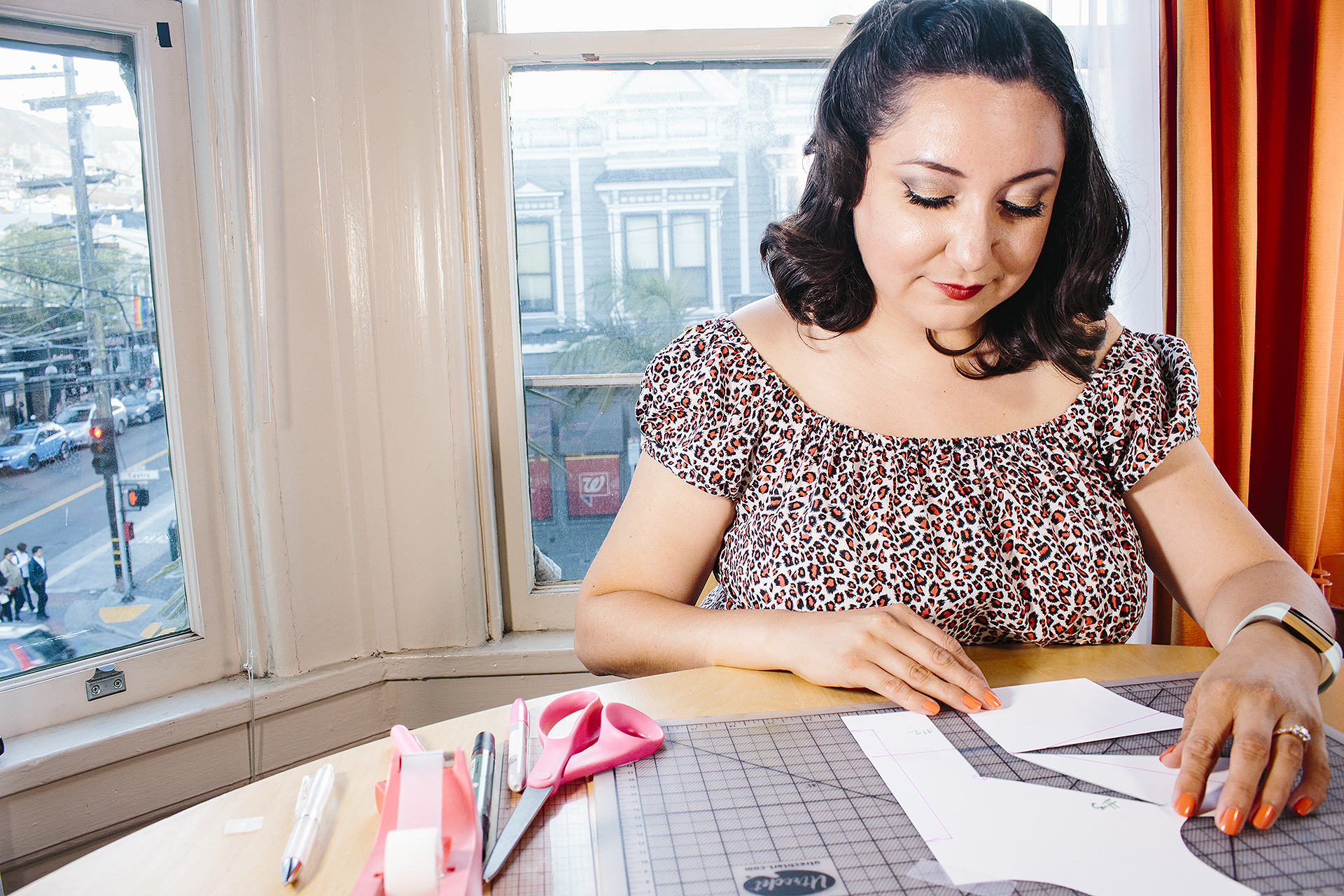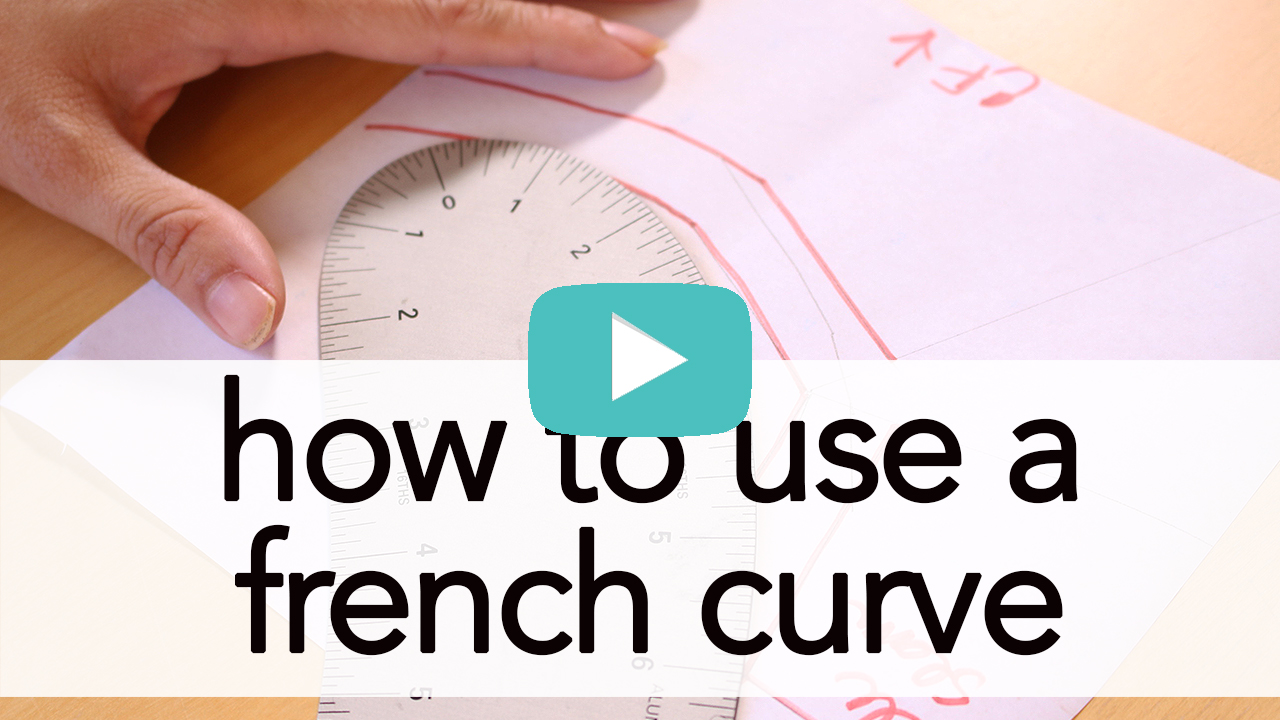
Do you know how to do a full bust adjustment?
The full bust adjustment (FBA) is not for the faint of heart. If you’re brand new to sewing, it can seem like a confusing mess.
The lines, slash and spread, and blending of curves can seem weird and nonsensical, and heaven forbid the adjustments need to be done on a non-conventional bodice! I remember that fear very well!
As a sewing blogger, I receive countless questions regarding FBAs on all sorts of patterns, but when it comes down to it, the adjustment is standard. If you know the principles of how to do this pattern adjustment, and how to approach it, you’ll be able to tackle some of the trickier garments!

Before discussing the Anatomy of an FBA…
Evaluate if you indeed need to perform one!
Not every pattern needs a full bust adjustment, even if you’re full busted.
I’m a big proponent of sewing the pattern straight from the envelope, before making a decision on the sorts of adjustments that change the foundation pattern.
Why?
- Sewing the standard size will give you an idea of how the pieces come together in general (not related to the FBA, but to understanding the garment)
- It’ll allow you to confirm whether the ease of the garment is right for you (the ease could potentially affect the size of the FBA)
- You’ll also be able to see if the FBA really will be needed for a better fit at the bust and arm scythe
I go into depth about my fitting process on my YouTube channel, where I have a dedicated playlist for Full Bust Adjustments.
Click to watch the FBA video tutorial playlist!
Another resource I recommend checking out is the Sewing Out Loud Podcast (STOP! Before you FBA), which dives deep into some of the current rhetoric around how Full Bust Adjustments are being used as sewing cure-alls. (HINT: they are NOT a fitting cure-all!)

Tools to Complete a Full Bust Adjustment
Before getting started doing an FBA, make sure you have your tools handy!

Paper Scissors – Sharp, simple, nothing fancy. I prefer one with a comfortable handle, which is easy to skimp on, but makes a difference long term.
Transparent Gridded Ruler – Look for one which is thin and flexible, which can bend around curves for pattern drafting. A regular ruler works fine, but transparent rulers will make your life easier with seam allowances, etc.
Tape – I recommend 3M Magic tape, which allows you to draw over and erase graphite.

Breaking down How a Full Bust Adjustment Works
The standard FBA features three lines, as outlined in the tutorial video.
Line One: Through the center of the primary dart, straight to the bust point.
This line dissects the dart in two, and allows for a bigger “tent” to be made in your fabric. Adjusting the overlap of the dart will adjust how much the fabric will fit over the cup.
Line Two: Parallel to the center front, straight down to the bottom of the bodice, starting at the bust point.
This line will allow the front bodice to be widened, creating for a wider space for the bust fit comfortably. NOTE: Most patterns are drafted to a B-Cup, and cup sizes above C-cup will need a little bit more space to be comfortable. The widening of the bodice adjusts the waist size as well, as widening at this line changes all measurements below the bust point.
Line Three: Bust point to last third of arm scythe.
The final line creates space for the “side boob”, spreading open space under the armpit. The exactly placement of this line is a general “final third” of the arm scythe, which is vague, as its specific placement isn’t specifically important. This line used as more of a pivot point. NOTE: The upper 2/3 of the arm scythe should be avoided as much as possible. Drafting this line out in the 2/3 or above area will start to distort the area above the bust, including the neckline, shoulders, sleeves, and fabric that sits above the bust.

What’s happening on the pattern?
As you spread the pattern pieces apart, a few different things are occurring:
The Center Front of the pattern piece stays exactly the same.
- The Center Front of the bodice front is staying stationary, as all pieces are pivoting around it.
- The Center Front piece will need to be lengthened, depending on the amount of the FBA, to match the Side Front (see below.)
Line One, which bisects the primary dart, opens to create a larger “tent” for the bust.
- A larger dart means there’s more space for the breast to sit forward comfortably.
The Side Front of the bodice lowers due to the main dart getting larger (at Line One.)
- With the Side Front lowering, it creates an offset with the Center Front, as noted above.
- The Center Front should match the Side Front, which is accurately accommodating the bust lengthwise (up and over the bust.)
Line Two, which splits the Center Front and Side Front, spreads apart the distance of the full bust adjustment.
- The spreading of Line Two creates width in the pattern below the bust point.
- The pattern is widening to accommodate the width of the breast.
- The waist measurement is expanded an equal amount.
- Ideally, the addition of space created by Line Two should reduce pulling at the sleeve and armpit, directly perpendicular to the bust point.
- Note: The pulling is generally created by the fabric straining to accommodate the bust, pulling at the seams of the sleeve/armpit area and smooshing the bust down.

Look for Pattern Distortions when Completing an FBA
Pattern Distortion #1: Center Front to Side Front
As discussed above, the Center Front should be lengthened to match the Side Front.
Warning! Simply drawing the Center Front line to square off with the Side Front and “lengthen it” doesn’t always work! If your pattern is not a simple bodice, on the fold, with a square edge, follow my pattern adjustment tutorial video by cutting a few inches from the Center Front piece and MOVING IT DOWN. The hem of the bodice may not always be straight, and this avoids accidental distortions.

Pattern Distortion #2: Mismatch on pattern true-ing
Areas that will need a look over include:
- The hem (see above)
- The dart itself
- How the front pattern piece fits against the back pattern piece
- The armhole (see below)
See my tutorial video to understand how to fix this distortion, How to Walk a Sewing pattern.
Pattern Distortion #3: Armhole
Line Three will create a pivot point at the armhole, and by completing the FBA, the pivot point pinches into the armhole. Use your French curve to correct the armhole by drawing a simple and gentle curve. (See: How to Use a French Curve)

Full Bust Adjustments can be intimidating, but they don’t have to be.
As you practice doing FBAs, the more complicated bodices operate in the same way. They add width for the bust line, they add length (up and over the bust), and they add a little extra for the side-boob.










